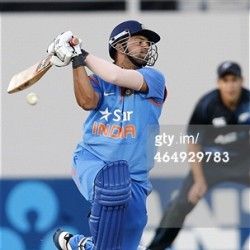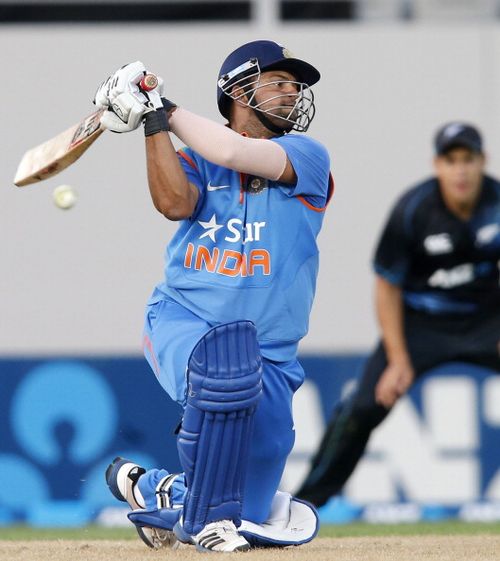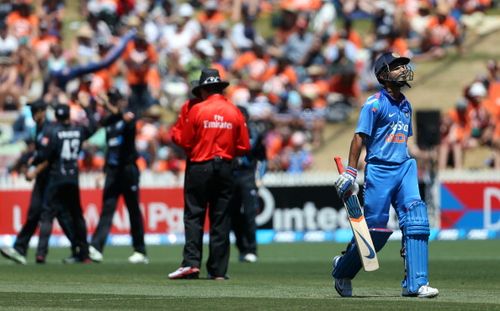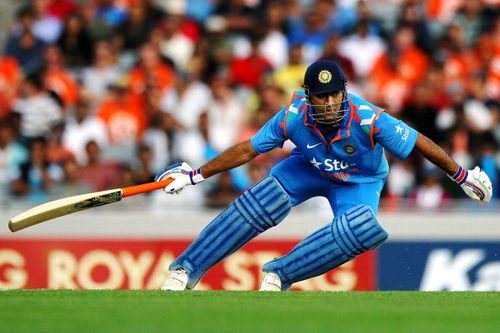
Running into trouble - the story of a shaky Indian middle order

Far too many expansive strokes are being tried by this Indian middle order
It’s not particularly wise to vilify individuals for what has been the shortcoming as a team. Neither is it entirely honest to snatch away the credit from the underdogs who have showcased immense responsibility and unrelenting resolution in their successful bid to overpower the World Champions and hog the limelight.
The extent of professionalism and shrewd cricket endured by the Kiwis right from day one is well confirmed by their persistent efforts to cash in on the few missing bricks in the otherwise impregnable Indian line-up. That they haven’t failed is evident from the series result which the New Zealand skipper has described as one ‘hell of an achievement’.
Whatever arguments Mahendra Singh Dhoni puts across for his bowlers’ failures seem invalid considering the fact that seamers from India had never really been known to terrify and annihilate opposition batsmen. In grounds like Auckland, where the straight boundary is lesser than 75 meters, not even the eternal optimist would have given the Mohammed Shamis and Bhuvneshwar Kumars a chance.
Where, then, lies the loophole? The sincerest answer will be the middle order.
Certain hiccups are overshadowed by positive results from matches and considering the tremendous amount of success India has tasted in recent years, it’s not a shocker that more than a handful of glitches have been overlooked and pushed under the carpet. Until recent times, of course, where they have returned to haunt Indian cricket with exaggerated nightmares.
The talent and potential of the Indian middle order is one of those unquestionable topics in world cricket. However, their lack of dedication, resilience and endurance remain conveniently unacknowledged by media and pundits alike. A couple of sentences regarding the dearth of responsibility in the middle order may grace the cover story of a newspaper on rare occasions, and that’s pretty much about it.
With the average age of the squad well below 30, expectations of better athleticism and agility on the field are not unsubstantiated. While the Suresh Rainas have been safe fielders inside the circle, they haven’t contributed likewise to batting.
It’s an established fact now – and a joy to the opposition – that if the middle order gets choked in between the two powerplays, India is destined to lose the match considering no miracle in the dying overs. And this, precisely, has been the case in the last couple of series.
Make no mistake, Shikhar Dhawan, Yuvraj Singh, Suresh Raina, Ajinkya Rahane are swift runners in between the wickets and can steal a couple of impossible runs in overthrows whenever they wish. That’s the keyword – wish. As things stand now, they simply do not wish to convert the ones into twos.

Dot balls lead to pressure, which ends up forcing the batsmen to play that release shot which can be risky
Statistics say that in the last two years, Indian batsmen have scored almost 50% of their runs in boundaries. That’s an overwhelming majority when records of other teams come into the scene. What has been the forte of Indians all these years – their penchant and accordingly nurtured skills of finding the ropes – seem to be backfiring now.
It’s not particularly a relishing sight for the average fan to watch the No. 4 and 5 swinging and missing, trying to eek out a boundary against the spinners in the middle overs. When reminded of the supposed agility in the young squad, it becomes terribly agonizing to watch Suresh Raina trudging away for a single after wasting four balls trying to penetrate the infield with strange swings.
Runs are certainly expected to dry up in the 15-35 overs and fetching the odd boundary every couple of overs may not be as effortless as it sounds. So it is of paramount importance to keep the scoreboard ticking with drives to the cow corner, long on and backward square leg.
The Indians, however, are averse to rotating the strike regardless of their nimbleness and potential to chip in quick singles. They would rather take their time holding the crease and attempt to bisect the deep cover and deep point when opportunity presents itself.
This leads to being stranded more often than not, with frustration seeping in and resulting in a desperate and completely unnecessary stroke through the air. There’s no point in faulting the shot selection when the actual culprit lies in the mindset and approach. Ten runs from five overs are barely flattering and should the batsman be blamed for attempting a preposterous scoop over the fine leg in an endeavour to break the shackles?
For an Australian or English, the desire to be allowed to be tied at one end of the crease would be utterly unfathomable, as would be the propensity to repeat the outrageous ventures every four-five overs. They’d simply manoeuvre the ball in between the gaps for a single, get to the non-striker’s end, take a deep breath and release the pressure.
Not only does the scoreboard keep on ticking, but it also exhausts the bowlers who are prone to commit errors while switching between different batsmen, especially when a left-hander pairs up with a right-hander at the crease. Loose balls are of more frequent occurrence and the batsmen are presented with delightful opportunities to free their arms and go for the kill.
In the third ODI at Eden Park, India could manage only 47 singles in comparison to 70 by the Kiwis in the middle overs. The pressure escalated when India found themselves playing 30 odd dot balls more than the home team in the same period. No wonder, Ravindra Jadeja and Ravichandran Ashwin had to deal with an enormous crisis towards the end.
With the batsmen trapped at one end, it’s becoming progressively easier for the opposition to pile up pressure with the required run rate kissing the 7 rpo mark. Denying the batsmen easy pickings to the square of the wicket, the ploy of forcing a risky shot every other over is turning out to be increasingly effective.

MS Dhoni’s art of building an innings by rotating strike is not being followed by a majority of his teammates
MS Dhoni may not want to pad up and walk down the wicket in every match, but that is exactly what he has been doing in the last couple of months. Considering the tremendous amount of exposure these cricketers are subjected to, courtesy BCCI’s eagerness to arrange more ODIs than any other board in a calendar year, this kind of obstinacy from so-called shot-makers stands unpardonable.
India has been getting away with this in the subcontinent, but they are awaiting more disastrous tours on foreign soil if this trend continues. Impersonating Australian cricket outright may not be the best option, but waiting eternally for the loose delivery isn’t a solution either. India has to learn balancing out singles along with boundaries and when that is done, Indian cricket will scale heights abroad.